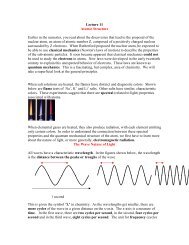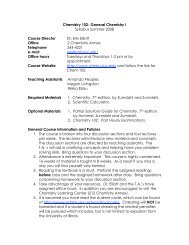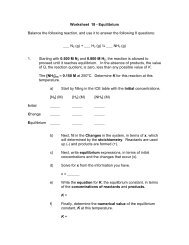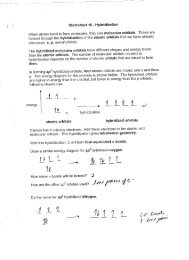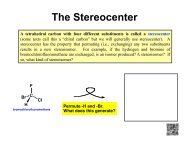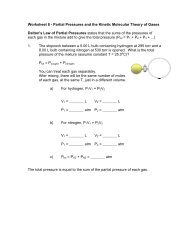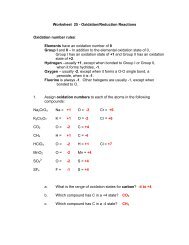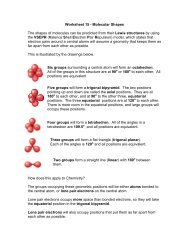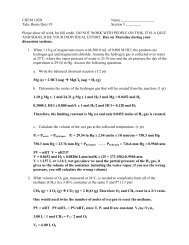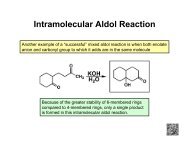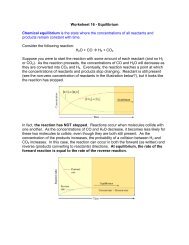Lab 2: The Diaper Lab
Lab 2: The Diaper Lab
Lab 2: The Diaper Lab
You also want an ePaper? Increase the reach of your titles
YUMPU automatically turns print PDFs into web optimized ePapers that Google loves.
<strong>Lab</strong> 2: <strong>The</strong> <strong>Diaper</strong> <strong>Lab</strong><br />
Chemistry 108, Spring 2010<br />
Goal:<br />
In this lab you will compare a generic disposable diaper with a name brand disposable diaper.<br />
You will experiment with the chemical responsible for absorbing the water (sodium<br />
polyacrylate) and you will decide which type of diaper is the better deal.<br />
Report:<br />
You have been hired as a free-lance author to write an article for Parent’s magazine. Write<br />
an article comparing the generic diaper with the name brand diaper. Discuss the tests you<br />
ran, what you found out, and give your opinion on the better of the two diapers (and how you<br />
arrive at this conclusion).<br />
Also include a discussion of sodium polyacrylate and how it works. Explain how salt affects<br />
the performance of sodium polyacrylate and how this relates to urine. Think about and<br />
describe at least two other uses for sodium polyacrylate besides its use in disposable diapers.<br />
<strong>The</strong> article should be informative, written for the layperson, scientifically accurate, and<br />
incorporate all of your observations, data, and calculations in an organized manner.<br />
Procedure:<br />
Part One: Making the Synthetic Urine<br />
1. Place 1000 mL (1 L) of deionized water in a large flask.<br />
2. Add 24.3 g of urea to the water and stir until dissolved.<br />
3. Add 10.0 g sodium chloride (NaCl), 6.0 g potassium chloride (KCl), and 6.3 g sodium<br />
dihydrogen phosphate (NaH 2 PO 4 ) to this solution and stir until dissolved.<br />
4. Add a few drops of yellow food coloring to the solution (for affect).<br />
Part Two: Comparing the Engineering of the <strong>Diaper</strong>s<br />
1. Make observations about both types of diapers. Compare their size, mass, how they are<br />
put together, etc.<br />
2. Tear apart each diaper and compare how the diapers are made. Be careful at this point to<br />
not lose any of the absorbent powder in the diapers.<br />
Part Three: Testing the Absorbent Powder and Sodium Polyacrylate with Pure Water<br />
1. Isolate as much absorbent powder from each type of diaper (generic and name brand) as<br />
you can. Do this by tearing apart the diaper, removing the stuffing, and shaking it in a<br />
Ziploc baggie.<br />
2. Measure 0.10 g of absorbent powder from each type of diaper and place each sample in a<br />
separate 250 mL beaker. Measure 0.10 g of sodium polyacrylate and place it in a 250 mL<br />
beaker.<br />
3. Take the mass of each of the beakers with the samples.<br />
4. Use a squirt bottle filled with deionized water to slowly add small amounts of water to<br />
each sample. Gently mix each sample (by mixing with a spatula or stirring rod) and wait<br />
a sufficient amount of time before adding additional water. It’s best to do this test with<br />
all three beakers at the same time (to make more of a direct comparison between them).<br />
5. Once you are convinced that as much water as possible has been absorbed, take the mass<br />
of the beakers with the gel in it. Determine the mass of water absorbed for each.
Chemistry 108, Spring 2010<br />
6. Add a spatula-tip filled amount of table salt (sodium chloride, NaCl) to each sample, stir,<br />
and make observations.<br />
Part Four: Testing the Sodium Polyacrylate with Synthetic Urine<br />
Repeat the procedure from Part Three with only the pure sodium polyacrylate (0.10 g) and<br />
using synthetic urine instead of deionized water.<br />
Part Five: Testing the Total Absorbency of the <strong>Diaper</strong>s<br />
1. Obtain two new diapers (one name-brand diaper and one generic diaper).<br />
2. Add 90.0 mL of synthetic urine to each of the diapers and record all observations. Pay<br />
attention to the time for absorption. <strong>The</strong> average bladder size of a one year old child is<br />
90 mL. Are both diapers able to adequately absorb this?<br />
3. Add synthetic urine to each of the diapers until the diaper cannot hold any more. <strong>The</strong><br />
diaper cannot hold anymore when you lay the diaper flat (so it forms a bowl-like shape)<br />
and the urine either drips out of the diaper or a pool of urine forms in the diaper. Record<br />
how much urine (in mL) each can hold.<br />
Part Six: Gathering General Information about the <strong>Diaper</strong>s<br />
1. Determine how much each package of diapers cost and the quantity per package.<br />
2. Calculate the cost per diaper for the generic and name-brand types.<br />
Data and Calculations:<br />
1. Include data and calculations for mass water absorbed per gram of sodium polyacrylate<br />
and mass “urine” absorbed per gram of sodium polyacrylate. Compare these ratios.<br />
2. Include data and calculations for mass water absorbed per gram of absorbent powder<br />
from the generic diaper.<br />
3. Include data and calculations for mass water absorbed per gram of absorbent powder<br />
from the name brand diaper.<br />
4. Include data for the total mass “urine” absorbed by the generic diaper. <strong>The</strong> density of<br />
urine is 1.014 g/mL. Use this density to assist you in converting from volume to mass.<br />
5. Include data for the total mass “urine” absorbed by the name brand diaper.<br />
-------------------------------------------------------------------------------------------------------------<br />
Paper Idea II:<br />
Write a paper on disposable diapers. Address at least the following questions:<br />
When were disposable diapers first introduced? How have they changed over the years?<br />
How much revenue is involved in the disposable diaper industry? How widespread is the use<br />
of disposable diapers as opposed to cloth diapers? What are the advantages and<br />
disadvantages of disposal diapers and cloth diapers?<br />
Note: Do not merely answer these questions in order, but write a coherent paper that<br />
addresses the above issues. <strong>The</strong> paper must be typed, should not be longer than 5 pages<br />
(double spaced, reasonable margins), and must include at least 2 references (web references<br />
are fine). <strong>The</strong> work must be your own.



